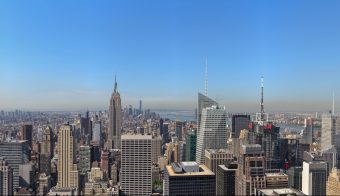Scientists estimate that at least 100 million and maybe as many as a billion birds die each year in the US when they collide with buildings, especially glass-covered or illuminated skyscrapers. And, in a new report, conservationists now have a better idea which American cities are the deadliest for those on the wing.

Chicago, with its many glass superstructures that spike into what is the busiest US avian airspace during migration, is the most dangerous city for those feathered travelers. More than 5 million birds from at least 250 different species fly through the Windy City’s downtown every fall and spring.
They journey twice a year, many thousands of miles, going north in the spring from Central and South America, across the Great Lakes to Canada, and back south in the fall.
The famous skyline of Manhattan is another death trap for birds, especially those migrating.
“They wind up landing somewhere that’s unfamiliar, like a sidewalk somewhere,” said Susan Elbin, director of conservation and science at New York City Audubon, a leading bird advocacy organization. “Then when daylight comes, and they want to get more food, they’ll fly into a tree that they think is a tree, and it’s really a reflected tree in some glass building … Then they’ll slam into the glass, and then they die.”
Most birds migrating through the US do so at night, when the airspace is cool and calm – and often end up veering through cities because their glow stands out. Scientists have long known that birds are attracted to light, so when they fly over a bright city at night, they are naturally drawn toward it, unaware they are in dangerous territory.
Any city with glass structures and bright lights at night is a culprit, but some are more dangerous to birds than others.
The Cornell Lab of Ornithology published a study this week that ranks cities based on the danger they pose to migrating birds.
Houston and Dallas, which also lie along some of the most popular migration paths, round out the top three most deadly cities after Chicago. New York, Los Angeles, St Louis and Atlanta also pose risks during migration.
Kyle Horton, an author of the Cornell study, said that the researchers were not trying to criticize cities per se.
“We’re trying to raise awareness – trying to provide data and insight that could help,” he said.
As the experts admit, it’s hard to get reliable statistics.
New York City Audubon conducts “collision monitoring studies” in September and April each year, sending dozens of volunteers into the city streets to track fallen birds. The organization estimates about 90,000 to 200,000 birds are killed via building collision in the city each year. Local Audubon chapters and other bird conservation groups around the country coordinate similar data collection exercises.
On a national scale, the Smithsonian’s migratory bird center estimated the number of deaths to be between 100 million and one billion birds annually, using data from a wide variety of different groups across the country.
Certain species of birds are more susceptible to building collisions. A separate study from the University of Michigan published this week found that songbirds, such as sparrows and warblers, are more likely to suffer collisions. Songbirds tend to emit “flight calls” during migration and are more likely to chirp when they see the bright lights of a city, potentially luring other birds into the treacherous skyline.
Though the studies bear sad news about the effects cities have on birds, conservationists see them as opportunities to target their activism.
“Every time new scientific literature comes out, we learn more about the problem, and … we can pinpoint the best solutions using the science,” said Kaitlyn Parkins, a conservation biologist at NYC Audubon.
Turning out the lights in buildings at night for a few weeks during peak migration is a simple first step and would make a big difference, Parkins said. The National Audubon Society runs Lights Out, a coordinated effort with local chapters to advocate reducing light during migration. States such as New York and Minnesota have participated in the program, turning out lights in state-operated buildings during migration.
Conservationists also advocate that buildings adopt more “bird-friendly” designs, for example using patterned glass and dimmer lighting. San Francisco and Toronto have already adopted some bird-friendly guidelines, while city council members in New York and Chicago have introduced legislation to adopt similar measures. A bipartisan bill in Congress introduced in January, called the “Bird-Safe Building Act”, would require new federal buildings to adopt designs that keep migrating birds in mind.
“We need to coexist with the ecosystem because we’re part of it, and so are birds,” Elbin said. “What’s good for birds is good for people.”
Source: Guardian



